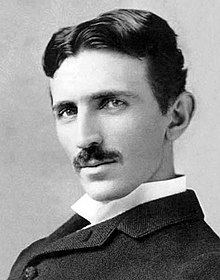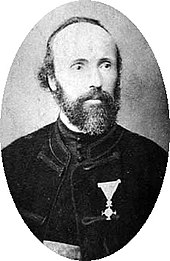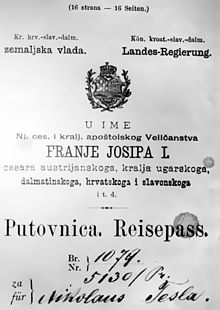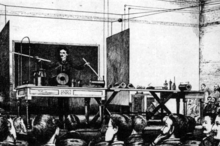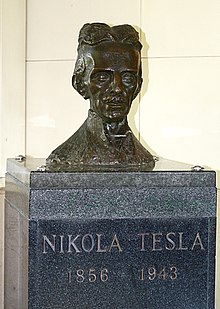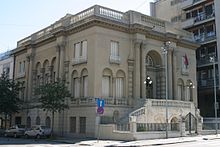Nikola Tesla
Nikola Tesla ( Serbian - Cyrillic Никола Тесла * 10. July 1856 in Smiljan , Croatian Military Frontier , imperial Austria , † 7. January 1943 in New York , USA ) was an inventor , physicist and electrical engineer . His life's work is shaped by numerous innovations in the field of electrical engineering , especially electrical energy technology , such as the development of the system for electrical energy transmission, now known as two-phase alternating current . Tesla has received over 280 patents in 26 countries, 112 of them in the United States.
Life
Origin and education

Nikola Tesla was born as the fourth of five children of Serbian parents in the village of Smiljan in the Lika not far from Gospić in today's Croatia . His parents were the Serbian Orthodox priest Milutin Tesla (1819–1879) and his wife Georgina (first name Đuka, née Mandić, 1822–1892). The house where he was born was the rectory of the St. Peter and Paul Church in Smiljan . In the baptismal register of the Orthodox Church, the date of birth was entered according to the Julian calendar . Nikola Tesla had three sisters and an older brother who died in a riding accident at the age of twelve when Nikola was five years old.
Nikola Tesla attended elementary and middle school in Gospić and from 1870 the grammar school in Karlovac . During his high school years he lived with his aunt Stanka and her husband Dane Branković, a retired colonel.
In 1875 he began his “Studium Generale” at the Imperial and Royal Technical University in Graz and attended an above-average number of lectures in the first year. On July 21, 1876 he was granted access to the main course in mechanical engineering. He got to know the Gramme machine from physics professor Jakob Pöschl , a then new type of DC generator from Zénobe Gramme . In the second year of study, his study activity decreased significantly. In the third year, he finished no exam and was finally by the university 1877/78 expelled after he had not paid the tuition money.
First professional employment
Tesla moved to Marburg an der Drau , where he found a job as a mechanical engineer. He spent his free time playing cards and billiards in relevant pubs. On March 24, 1879, Tesla was expelled from Marburg / Maribor by police order and sent back to his home town of Gospić. A month later, in April 1879, his father died. After his death, Tesla initially stayed in Gospić and took a job as a substitute teacher.
In 1880, with financial support from his uncle Dane Branković, Tesla went to Prague to complete his studies at the then German-speaking Charles University there. However, neither the attendance nor the completion of the lectures he has attended is documented; the necessary tuition fees were never paid either.
From 1881 to 1882 Tesla lived in Budapest, where in 1882 he found a job as a telegraph operator at Tivadar Puskás , who at that time represented Thomas Alva Edison's companies in Europe.
With a recommendation from Puskás, Tesla moved to Paris at the end of 1882 to join Charles Batchelor , who ran one of the leading Edison companies in France. In addition to other activities, Tesla was in charge of the newly installed electrical lighting at Gare de l'Est in Paris from November 1883 to February 1884 .
Move to New York
On June 6, 1884, Tesla moved to New York with virtually no funding. Just two days later, on June 8, 1884, he started working for the Thomas Alva Edisons company. This employment relationship only existed until December 7, 1884, when it was terminated by Tesla due to differences in salary expectations.
In March 1885, Tesla and two business people founded the Tesla Electric Light and Manufacturing Company , based in Rahway . In 1885 the first patents such as Tesla's arc lamp and a new type of commutator were applied for and incorporated into the company. The two business partners betrayed Tesla, however. Participation was only important to them in order to avoid license payments to other lamp designers. At the end of 1886, the company also filed for bankruptcy.
In the spring of 1887 Tesla was temporarily unemployed, worked as a day laborer in road construction and met the superintendent of the Western Union Alfred S. Brown and the lawyer Charles F. Peck through chance acquaintances . Tesla's ideas about a rotating magnetic field, a so-called rotating field , formed from two alternating currents that are 90 ° out of phase with each other and are known today as two-phase alternating current , convinced Brown and Peck. In April 1887, Tesla was able to found its second company, Tesla Electric Company , as a partner and deal with the first work on two-phase alternating current. By May 1888, seven patents had been applied for (Peck is registered as a co-owner alongside Tesla), which dealt with multiphase alternating current and its transmission, the so-called polyphase patents. One of the most important patents hereof, US Patent No. 381,968, describes the first two-phase synchronous machine, which is a three-phase machine. In April 1888, publications in renowned specialist journals such as the Electrical Review and the Electrical World followed, which resulted in a certain level of awareness in specialist circles.
On May 16, 1888, Tesla was invited to give a talk on polyphase alternating current at the American Institute of Electrical Engineers (AIEE, now IEEE). This lecture, known as the New York Lecture , attracted a lot of attention and led to industrialist George Westinghouse becoming aware of Tesla. Westinghouse, who found himself in a dispute with Edison called the later current war , secured the rights to Tesla's polyphase patents in mid-1888, but in the following ten years had to spend considerable funds in defending those patents against Galileo Ferraris , who practically simultaneously and invented the three-phase system independently of Tesla. Independently of Tesla, Michail Ossipowitsch Doliwo-Dobrowolski invented the three-phase system that is common today in electrical power engineering and power grids in 1888 .
From July 1888 to July 1889, Tesla worked together with technicians from Westinghouse in Pittsburgh on the practical implementation of AC voltage systems - several patents date from that time, including those for converting direct current to alternating current . The collaboration was not free of conflict: Tesla was used to working as a "lone warrior" and found it difficult to integrate. Technically, the existing Westinghouse machines were single-phase generators, designed for a mains frequency of 133 Hz. Tesla's machines were designed for multi-phase alternating current for 60 Hz. In 1890, the line frequency of 60 Hz, which is still common in North America today, and the multi-phase system finally prevailed at Westinghouse. At the same time a dispute broke out in the so-called current war between Edison, who favored a direct current system, and Westinghouse, who favored an alternating current system.
1889 to 1900
In August 1889, after a short European stay in Paris and his home town of Gospić, Tesla moved to New York, where he set up a laboratory on Grand Street and began to deal with high-frequency alternating currents and electromagnetic waves . At that time he was living in first-class hotels like the Astor House on Broadway , free from financial worries . In 1890, several patents were issued, including on break contacts, multi-pole alternating voltage generators and resonance transformers, the so-called Tesla transformers , in order to improve the arc lamp with spark gaps .
The idea that Tesla was pursuing at the time and that would never let go of him was to enable wireless energy transmission using high-frequency alternating currents . To this end , he experimented with Geissler tubes , an early form of gas discharge tube, and held regular demonstrations in which he let the Geissler tubes glow without a cable connection between electrodes placed in the room. This impressive spectacle mostly astonished the audience. As a result of these demonstrations, William Arnold Anthony , then President of the AIEE, invited him to give a lecture on May 20, 1891 at Columbia College , New York. This lecture, known as the Columbia Lecture , a mixture of specialist lecture and stage show, received a lot of attention, but also received displeasure due to its occult style, for example from Mihajlo Pupin , then a physics professor at Columbia University .
As a result of the Columbia Lecture and his public appearances, Tesla became known in New York high society. This opened various social doors for him. Among other things, he received American citizenship on July 31, 1891. From February 1892 to the end of August 1892 Tesla stayed in Europe, including London, where he gave a revised version of his Columbia Lecture on February 3, 1892 before the Institution of Electrical Engineers (IEE) and then at the Royal Institution of Great Britain . This was followed by presentations in Paris, after which he traveled to his home town of Gospić, where his mother died on April 16, 1892.
Despite the economic crisis in the USA in 1893, Westinghouse exhibited Tesla's Egg of Columbus at the World's Columbian Exposition in Chicago (this world exhibition was dedicated to the discovery of America by Christopher Columbus) . This demonstration set-up was intended to illustrate the effect of the rotating magnetic field using a metallic egg and its rotation and to create a mood for the alternating current system represented by Westinghouse in the context of the electricity war. At the same time, Tesla moved into the New York Hotel Gerlach in 1893 , which already had electric lights and an elevator. He also set up a larger laboratory on West Broadway that year and employed five mechanics. In his new laboratory, he had cables running around the ceiling and fed by a Tesla oscillator. This made it possible to walk around with Geissler tubes while the tubes glowed wirelessly due to the high electrical field strengths. In the same year lectures on these experiments at the Franklin Institute in Philadelphia and media-acclaimed presentations at the World's Columbian Exposition in Chicago followed. He practically exhibited himself and created corona discharges and their optical light phenomena on the surface of his clothing and hair through high-frequency alternating currents, which are safe up to a certain level due to the skin effect .
Tesla was also very active in New York high society in the 1890s and lived an expensive lifestyle. For example, he had a habit of throwing away leather gloves and ties after a week and replacing them with new ones. During this time he made contact with the theater diva Sarah Bernhardt and the banker JP Morgan . During this time he also had to cope with setbacks: On March 13, 1895, a fire destroyed his laboratory with all devices, documents and records. The fire was started by a heating company that was located in the same building on the ground floor. This led to a depressed phase. Although he was able to set up a new laboratory in the same year, his financial situation deteriorated as a result towards the end of 1895.
In 1896 Tesla dealt with the then newly discovered X-rays ; In 1897 he again devoted himself intensively to the ideas for wireless energy and communication transmission, which to a certain extent competed with the work of the radio pioneer Guglielmo Marconi . Tesla was also working on other topics at the time, such as a 1.1-meter-long unmanned submarine that could be wirelessly remote-controlled and loaded with explosives was supposed to be used in the Spanish-American War , but was never used.
At the end of 1898, Tesla moved into the New York luxury hotel Waldorf-Astoria and was able to win its wealthy owner, John Jacob Astor IV , as an investor. Tesla's finances became more of a problem for him in 1898 as his expenses exceeded the irregular income from licenses and occasional lectures. Westinghouse supported Tesla with a loan, but Tesla had to forego part of the license income from its patents. In addition, his New York laboratory had become too small for the ever larger setups for testing his wireless energy transmission.

Inspired by his patent attorney, who owned shares in the El Paso Electric Company in Colorado Springs , Tesla built a larger laboratory in May 1899 in the then sparsely populated area around Colorado Springs. Tesla wanted to use the planned systems to wirelessly transmit "news and energy" from the east coast of the USA to a planned receiving station in France until the Paris World Exhibition in 1900 . The wooden laboratory contained various coils and structures and in the middle an iron mast that could be extended to a height of 50 m, which was intended to catch lightning discharges. In the diary he kept at the time, Tesla referred to this structure as a magnifying transmitter , but at the same time tried to keep as little information as possible about it. Outsiders were not allowed to enter his laboratory in Colorado Springs.
In his experiments with lightning discharges, he also described the standing waves that occur in the low-frequency range in the atmosphere , which are now known as Schumann resonance . He could not systematically classify these observations, and around 1900 the structure of the atmosphere and the ionosphere were still unknown. Winfried Otto Schumann was only able to explain these observations 50 years later .
During his experiments in Colorado Springs, parts of the laboratory were repeatedly set on fire by artificial and natural lightning discharges. In October 1899, Tesla increased the output to the point that the El Paso Electric Company's generator burned out and the city of Colorado Springs had no electricity for days. At the time, Tesla was convinced that it had found a functioning “world energy system”. In December 1899, several pictures were taken in and around the laboratory for advertising purposes by the chief photographer of the then renowned Century Magazine, Dickenson V. Alley. Tesla moved to New York on January 7, 1900 and left the lab as it was. He didn't pay the outstanding utility bills or the wages of his workers - five years later, Tesla was charged with this debt, and the laboratory's facilities and materials were sold as building materials.
1900 to 1912
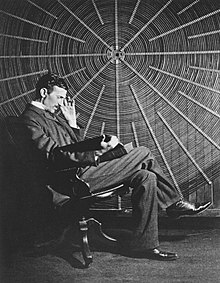
On March 20, 1900, Tesla received its first patent for wireless energy transmission, which is now the first patent for wireless technology , although it wanted to use it to transmit energy for lighting. One month later, on April 26, 1900, Guglielmo Marconi applied for his patent for wireless telegraphy - Marconi should succeed in realizing the first wireless transatlantic radio link between North America and Europe.
After 1900, Tesla's work became increasingly whimsical, with a penchant for transcendentalism and areas of metaphysics . Tesla interpreted humans as a machine ( automáton ) that is completely determined by external driving forces , especially solar energy . In the middle of 1900 he published an extravagant article on the increase of human energy in Century Magazine under the title The Problem of Increasing Human Energy , in which the advocate of an energetic vegetarianism, who also advocates a preferred vegetarian diet, draws an apocalyptic prophecy about the present and future of humanity above all proposes the utilization of solar energy as a “natural source of energy supply for mankind”. This also includes his idea of wireless energy transmission for all of humanity. Among other things, he claims that “the energy of a person is determined by half of his mass, multiplied by the square of an as yet unknown speed”. The increase in that human energy is possible through "food, peace and work". The article, which also references a Tesla patent on a “world energy system,” aroused severe criticism in professional circles and the media, including in major US newspapers, in which he was described as a dreamer and impractical inventor .
However, Tesla was not impressed by this and speculated in the January 1901 issue of the high-circulation US magazine Collier's Weekly about the possibility of communication with other planets. In March 1901 he registered his patent for an apparatus for using radiant energy with US Pat. No. 685.957, which is supposed to capture “space energy” and convert it into electrical energy. This work is given as a source until today in parts of that parascience in which an always available and practically free so-called “ free energy ” or “space energy” is propagated.
At the end of 1900 Tesla's financial situation deteriorated again. His previous investor, the hotelier Astor, was no longer interested in Tesla's antics. As a result, Tesla became increasingly involved in upscale New York society and spent time at various social events. In February 1901 he succeeded in winning the banker JP Morgan as a new investor.
With the help of JP Morgan's investment, Tesla was able to begin building the Wardenclyffe Tower on Long Island's north shore in 1901 . In the course of the project there were differences with his sponsor, among other things because Tesla presented the project to JP Morgan as a high-performance radio transmitter for transmitting messages, but in reality he wanted to use the tower to realize his dream of worldwide wireless energy transmission. Morgan was interested in a radio system in competition with Marconi, for example to have stock market news from Europe more quickly available. When Tesla informed JP Morgan about the actual task of the Wardenclyffe Tower in September 1902, the latter withdrew from the project. The business relationship with JP Morgan finally broke up in 1904.
In 1905, the Wardenclyffe Tower project stalled and Tesla's financial problems grew more precarious. He could no longer pay the employees and legal proceedings ensued from his time in Colorado Springs . At the end of 1905 and the following years up to 1908, Tesla withdrew more and more, occasionally writing articles, experimenting on himself with electroshock therapy methods and at times becoming addicted to alcohol. The tower was not completed and never went into operation.
Its situation improved in 1908 with the invention of the Tesla turbine , a form of the disc rotor pump which aroused the interest of John Hays Hammond , who had become rich in gold mining . With the new investor, he was able to found the Tesla Propulsion Company in New York. From 1909 he began to repay part of his debts. However, the Tesla turbine could not be brought to series production with the material technology of the time and is hardly used today due to practical manufacturing problems. In the years after 1910 his financial problems intensified again.
1913 to 1943
In 1913, Tesla had Elisabeth Vilma Lwoff-Parlaghy portray herself in oil paints in several sessions . During the first presentations of the portrait, he installed extra light bulbs with blue light filters. The picture therefore became known as the Blue Portrait and was presented at sales exhibitions in New York in 1913 and 1916. But there were no buyers and the painting remained the property of the artist. After the painter's estate had been auctioned off, it was considered lost until it was rediscovered in the Husum NordseeMuseum-Nissenhaus in the early 2000s and recognized as the Blue Portrait in 2009.
At the end of 1913, Tesla tried to sell prototypes of its Tesla turbine to Bergmann-Elektrizitätswerke based in Germany , but failed because of the transport costs. In the same year, in the tension before the First World War , he tried to find financiers in the German Empire, published magazine articles on various branches of arms such as “automatic air torpedoes” and showed admiration for various branches of the German armed forces. In 1914, after Germany declared war on Russia, all German overseas cables were cut by the British Navy - the remaining communications link was a radio station in Sayville operated by the American subsidiary of Telefunken . However, this radio station had insufficient transmission power to be able to transmit messages to Europe without a relay ship in the Atlantic. In 1914, also because of its financial problems, Tesla accepted the order to improve this vital station. This led the American secret service to become aware of him.
In 1916 he patented his Teslav valve , which is based on the fact that the flow resistance in one flow direction is lower than in the opposite, which enables a rectifying effect to be achieved.
Tesla also wrote various publications on the subject of war technology at the time. For example, in August 1917 an article in the journal Electrical Experimenter dealing with fantastic weapon systems against submarines. He wanted to send out "concentrated beams of high frequency".
Around 1930, Tesla was barely able to provide for a living as a result of the economic crisis and was living on credit in New York hotels. In 1933 the Westinghouse Company agreed to pay him a monthly fee for his advisory work. On January 1, 1934, he moved to the Hotel New Yorker. At the end of his life as an inventor, he withdrew more and more and, among other things, dealt with "ray cannons" around 1935.
Tesla was found dead by staff at the Hotel New Yorker on the morning of January 8, 1943, at the age of 86 ; the doctor entered January 7, 1943 on the death certificate as the time of death. His records and his hotel room belongings were confiscated by US officials from the Office of Alien Property Custodian , even though Tesla was a US citizen - it was feared his records could be taken overseas. The urn with his ashes has been in the Nikola Tesla Museum in Belgrade since 1952 .
Awards and honorary doctorates
In 1916, Tesla was awarded the AIEE Edison Medal for its achievements . In the 1930s he was awarded a total of twelve honorary doctorates , including from the University of Prague , in 1937 from the Graz University of Technology and the universities in Brno, Bucharest and Paris. In the USA alone he was able to register 112 patents in around 50 years of work .
Honors
Monuments



- Statue in front of Belgrade University
- Statue in the State Park of Niagara Falls
- Bust in the Massachusetts Institute of Technology
- Statue in Palo Alto , Silicon Valley
- Bust in front of the University in Zagreb
- Statue in Smiljan (Croatia)
- Statue in Zagreb (Croatia)
Tesla as namesake
- The physical unit of magnetic flux density has been named after Nikola Tesla since 1960 , the Tesla , abbreviated with the capital letter T:
- The lunar crater Tesla and the asteroid (2244) Tesla were named after him.
- The American rock band Tesla was also named after him.
Company and products
- Tesla as was the name of a large state electrotechnical company in the ČSSR , which was called Electra until it was renamed in honor of Nikola Tesla on March 7, 1946. Its exports made Tesla a well-known brand name in Comecon countries.
- Nikola Tesla is the namesake of Tesla, Inc. , a Californian manufacturer of electric cars with AC motors.
- In 2008 Autodesk released a version of Autodesk Inventor , in which Tesla's name was the inspiration for the company's internal name.
Technical facilities
- Nikola Tesla Airport in Belgrade, Serbia
- Nikola Tesla thermal power station near Obrenovac , the largest coal-fired power station complex in Serbia
- A large, but not realized, particle accelerator project near Hamburg was given the acronym TESLA - among other things because it was supposed to break new ground in superconductivity and magnetic technology. The plans for TESLA were incorporated into the plans for the International Linear Collider (ILC).
Others
- Nikola Tesla Laboratory and Nikola Tesla Scholarship (funding for a stay abroad) at the Graz University of Technology
- The Nikola Tesla Medal for “inventive researchers” from Graz University of Technology, Graz University and MedUni Graz was first awarded on November 24, 2015 to the information technician Gernot Kubin .
Tesla museums
- Nikola Tesla Memorial Museum (Birthplace) in Smiljan (Croatia)
- Nikola Tesla Museum in Belgrade (Serbia), part of the UNESCO World Document Heritage
- Tesla Museum in Gallspach (Austria)
Banknotes and commemorative coins
- Shown on numerous Yugoslav and Serbian banknotes: 500 Yugoslav dinars (1970-86), 1,000 Yugoslav dinars (1990, 1991, 1992), 5,000,000 Yugoslav dinars (1993), 10,000,000,000 Yugoslav dinars (1993), 5000 Yugoslav dinars ( 1993), 100 Yugoslav dinars (1994), 5 new Yugoslav dinars (1994), 100 Serbian dinars (2007)
- Numerous commemorative coins from the Serbian and Croatian national banks in gold and silver
Mentions in popular culture
Nikola Tesla's work was mentioned in various films, television series, books and computer games, including
- The Secret of Nikola Tesla (1980), played by Petar Božović
- Moon Palace (1989), novel by Paul Auster (German: moon over Manhattan )
- Tesla (1993), played by Svetozar Cvetković
- Variations of his Tesla coil , which as a weapon in various games of Command - Conquer franchise - and are used
- Tesla: Master of Lightning (2000), voiced by Stacy Keach
- Thomas Pynchon : Against the Day (2006)
- Prestige - The Masters of Magic (2006), played by David Bowie
- the Canadian television series Sanctuary (2008), played by Jonathon Young
- the American science fiction series Warehouse 13
- as the spaceship USS Tesla (Nebula-class) in Star Trek .
- Computer game: Armada II (Star Trek TNG)
- Computer game: The Order: 1886
- Computer game: An Armor in Fallout 4 , 2015
- a steampunk subgenre, in which electricity is more in the foreground, is called "Teslapunk".
- Edison: A Life Full of Light (2017), played by Nicholas Hoult .
- In the episode Unter Strom (2020) of the series Doctor Who , The Doctor meets Tesla.
- In the 2020 movie Tesla , Tesla is played by Ethan Hawke .
Fonts
- Ulrich Heerd (Ed.): Nikola Tesla. His work (own records only) 6 vols. Edition Tesla. Michaels-Verlag, Peiting 2002, ISBN 3-89539-247-2 .
- Vol. 1 Hochfrequenzexperimente, ISBN 3-89539-240-5 .
- Vol. 2 My inventions, ISBN 3-89539-241-3 .
- Vol. 3 AC and high frequency technology, ISBN 3-89539-242-1 .
- Vol. 4 Energy transmission and radio technology, ISBN 3-89539-243-X .
- Vol. 5 Pioneers of the New Medicine, ISBN 3-89539-244-8 .
- Vol. 6 Weapon Technology, ISBN 3-89539-245-6 .
- Investigations into multiphase currents etc. Halle 1895.
- My Inventions, Barnes and Noble 1982 (reprint of the edition first published in 6 parts February to June 1919 in the journal Electrical Experimenter , foreword by Ben Johnson)
literature
- Robert Lomas: The Man Who Invented the Twentieth Century. Nikola Tesla, Forgotten Genius of Electricity. Headline, London 2000, ISBN 0-7472-6265-9 .
- Margaret Cheney: Nikola Tesla. A biography. Omega, Düsseldorf 2001, ISBN 3-930243-01-6 .
- Michael Krause: How Nikola Tesla invented the 20th century. Wiley-VCH, Weinheim 2009, ISBN 978-3-527-50431-2 .
- Snežana Šarboh: The patents of Nikola Tesla. World Patent Information 32.4 (2010) pp. 335-339.
- W. Bernard Carlson: Tesla. The inventor of the electric age. 2nd Edition. FinanzBook, Munich 2017, ISBN 978-3-95972-007-6 . (American original edition: Tesla. Inventor of the Electrical Age. Princeton University Press, Princeton 2013)
- K. Jäger, F. Heilbronner (ed.): Lexikon der Elektrotechniker, VDE Verlag, 2nd edition from 2010, Berlin / Offenbach, ISBN 978-3-8007-2903-6 , p. 429
Web links
- Literature by and about Nikola Tesla in the catalog of the German National Library
- Nikola Tesla in the Internet Movie Database (English)
- Some listed patents (numbers and designations) as download (Word document) (DOC file; 82 kB)
- Tesla - Master of Lightning - a PBS documentation (English)
- Nikola Tesla Museum in Belgrade (Serbian / English)
- worldwide.espacenet.com: Patent search on "NIKOLA TESLA"
- Dario Stanković: Prošlo 155 godina od rođenja Nikole Tesle a njegova djela postaju sve veća. ( 155 years since Nikola Tesla was born ). In: Nezavisne. July 9, 2011 (Serbian).
Individual evidence
- ↑ Jelenković, Vladimir. Towards a definitive catalog of the patents of Nikola Tesla. World Patent Information 32.2 (2010): 147-149. APA (online)
- ↑ The family Tesla teslasociety.ch
- ↑ Cf. birth certificate with extract from the baptismal register: The date of birth is given as June 28, 1856 according to the Julian calendar (= July 10, 1856 according to the Gregorian calendar).
- ^ Franz Pichler, Augustinus Asenbaum: On the study of Nikolaus Tesla in Graz and Prague . February 1996 ( Online [PDF; 235 kB ]).
- ↑ Michael Krause: How Nikola Tesla invented the 20th century . 1st edition. Wiley, 2010, ISBN 978-3-527-50431-2 , pp. 74 to 76 .
- ↑ Michael Krause: How Nikola Tesla invented the 20th century . 1st edition. Wiley, 2010, ISBN 978-3-527-50431-2 , pp. 95 .
- ↑ Patent US335786 : Arc lamp with carbon electrodes controlled by electromagnets or solenoids and a clutch mechanism; Corrects earlier design flaws common to the industry.
- ↑ Patent US334823 : Commutator for Dynamo Electric Machines.
- ↑ Michael Krause: How Nikola Tesla invented the 20th century . 1st edition. Wiley, 2010, ISBN 978-3-527-50431-2 , pp. 100 .
- ↑ Michael Krause: How Nikola Tesla invented the 20th century . 1st edition. Wiley, 2010, ISBN 978-3-527-50431-2 , pp. 101 .
-
↑ Patent US381968 : Mode and plan of operating electric motors by progressive shifting; Field magnet; Armature; Electrical conversion; Economical; Transmission of energy; Simple construction; Easier construction; Rotating magnetic field principles. Patent US381969 : Novel shape and operating mode; Coils forming independent energizing circuits; Connected to an alternating current generator; Synchronous motor. Patent US381970 : Current from a single source of supply in the main or Transmitting circuit induce by induction apparatus. Patent US382279 : rotation is produced and maintained by direct attraction; Utilizes shifting poles; Induction magnetic motor. Patent US382280 : New method or mode of transmission; Dynamo motor conversion with two independent circuits for long distance transmission; Alternating current transmission. Patent US382281 : Improvements in electromagnetic motors and Their fashion or methods of Their operations. Patent US382282 : Method of Converting and Distributing Electric Currents.
- ↑ Nikola Tesla: A New System of Alternating Current Motors and Transformers . American Institute of Electrical Engineers, May 1888 ( HTML version from 21st Century Books).
- ↑ Michael Krause: How Nikola Tesla invented the 20th century . 1st edition. Wiley, 2010, ISBN 978-3-527-50431-2 , pp. 115 .
- ^ Gerhard Neidhöfer: Michael von Dolivo-Dobrowolsky and three-phase current: the beginnings of modern drive technology and power supply . 2nd Edition. VDE-Verlag, 2008, ISBN 978-3-8007-3115-2 .
- ↑ Michael Krause: How Nikola Tesla invented the 20th century . 1st edition. Wiley, 2010, ISBN 978-3-527-50431-2 , pp. 121 .
- ↑ Michael Krause: How Nikola Tesla invented the 20th century . 1st edition. Wiley, 2010, ISBN 978-3-527-50431-2 , pp. 129 .
- ↑ Patent US433702 : Electrical Transformer Or Induction Device.
- ↑ Michael Krause: How Nikola Tesla invented the 20th century . 1st edition. Wiley, 2010, ISBN 978-3-527-50431-2 , pp. 133 .
- ↑ Michael Krause: How Nikola Tesla invented the 20th century . 1st edition. Wiley, 2010, ISBN 978-3-527-50431-2 , pp. 137 .
- ↑ Michael Krause: How Nikola Tesla invented the 20th century . 1st edition. Wiley, 2010, ISBN 978-3-527-50431-2 , pp. 155 .
- ↑ Patent US514168 : Means for Generating Electric Currents.
- ↑ Michael Krause: How Nikola Tesla invented the 20th century . 1st edition. Wiley, 2010, ISBN 978-3-527-50431-2 , pp. 187 .
- ↑ Michael Krause: How Nikola Tesla invented the 20th century . 1st edition. Wiley, 2010, ISBN 978-3-527-50431-2 , pp. 121 .
- ↑ Michael Krause: How Nikola Tesla invented the 20th century . 1st edition. Wiley, 2010, ISBN 978-3-527-50431-2 , pp. 192 .
- ↑ Michael Krause: How Nikola Tesla invented the 20th century . 1st edition. Wiley, 2010, ISBN 978-3-527-50431-2 , pp. 208 .
- ↑ Patent US649621 : Apparatus for Transmission of Electrical Energy.
- ↑ Michael Krause: How Nikola Tesla invented the 20th century . 1st edition. Wiley, 2010, ISBN 978-3-527-50431-2 , pp. 218 .
- ↑ Patent US613809 : Method of and Apparatus for Controlling Mechanism of Moving Vehicle or Vehicles.
- ↑ Patent US725605 : System of Signaling.
- ↑ Michael Krause: How Nikola Tesla invented the 20th century . 1st edition. Wiley, 2010, ISBN 978-3-527-50431-2 , pp. 224 .
- ↑ Michael Krause: How Nikola Tesla invented the 20th century . 1st edition. Wiley, 2010, ISBN 978-3-527-50431-2 , pp. 231 .
- ↑ Patent US645576 : System of Transmission of Electrical Energy.
- ^ Gundolf Keil : Vegetarian. In: Medical historical messages. Journal for the history of science and specialist prose research. Volume 34, 2015 (2016), pp. 29–68, here: p. 59.
- ^ Tesla, Nikola: The Problem of Increasing Human Energy, with Special Reference to the Harnessing of the Sun's Energy. June 1900 ( online ).
- ↑ Patent US787412 : Art of Transmitting Electrical Energy through the Natural Mediums.
- ↑ Chicago Daily News, January 6, 1901 issue
- ↑ Nikola Tesla: Talking with the planets , Collier's Weekly, 9.2.1901
- ↑ Patent US685957 : Apparatus for the Utilization of Radiant Energy.
- ↑ Michael Krause: How Nikola Tesla invented the 20th century . 1st edition. Wiley, 2010, ISBN 978-3-527-50431-2 , pp. 244 .
- ↑ Michael Krause: How Nikola Tesla invented the 20th century . 1st edition. Wiley, 2010, ISBN 978-3-527-50431-2 , pp. 249 .
- ↑ Michael Krause: How Nikola Tesla invented the 20th century . 1st edition. Wiley, 2010, ISBN 978-3-527-50431-2 , pp. 262-267 .
- ↑ Michael Krause: How Nikola Tesla invented the 20th century . 1st edition. Wiley, 2010, ISBN 978-3-527-50431-2 , pp. 273 .
- ↑ Michael Krause: How Nikola Tesla invented the 20th century . 1st edition. Wiley, 2010, ISBN 978-3-527-50431-2 , pp. 285 .
- ↑ Nikola Tesla's "Blue Portrait" by Princess Vilma Lwoff-Parlaghy
- ↑ Husum inventory (PDF; 47 kB)
- ↑ Rediscovery of the "blue portrait" after 85 years (PDF file 542 kB)
- ↑ Michael Krause: How Nikola Tesla invented the 20th century . 1st edition. Wiley, 2010, ISBN 978-3-527-50431-2 , pp. 297 .
- ↑ Michael Krause: How Nikola Tesla invented the 20th century . 1st edition. Wiley, 2010, ISBN 978-3-527-50431-2 , pp. 301 .
- ↑ Michael Krause: How Nikola Tesla invented the 20th century . 1st edition. Wiley, 2010, ISBN 978-3-527-50431-2 , pp. 337 .
- ↑ Michael Krause: How Nikola Tesla invented the 20th century . 1st edition. Wiley, 2010, ISBN 978-3-527-50431-2 , pp. 351 .
- ↑ Andreas Ernst: Disturbed calm of a brilliant inventor. In: Neue Zürcher Zeitung . March 20, 2014.
- ↑ Michael Krause: How Nikola Tesla invented the 20th century . 1st edition. Wiley, 2010, ISBN 978-3-527-50431-2 , pp. 368 .
- ↑ TU-Graz: A pioneer in electrical engineering queried on December 18, 2010
- ↑ Nikola Tesla Scholarship , Graz University of Technology, accessed May 6, 2013
- ^ Tesla Medal, Kleine Zeitung Print, November 19, 2015, p. 26.
- ^ Tesla, Nikola (encyclopedia entry). In: Meyers Großes Konversations-Lexikon. 6th edition, Bibliographisches Institut, Leipzig / Vienna 1905-1909. 1909, Retrieved May 29, 2018 .
| personal data | |
|---|---|
| SURNAME | Tesla, Nikola |
| BRIEF DESCRIPTION | Inventor and electrical engineer |
| DATE OF BIRTH | July 10, 1856 |
| PLACE OF BIRTH | Smiljan , Croatia (at the time part of Austria-Hungary) |
| DATE OF DEATH | January 7, 1943 |
| Place of death | New York City |
